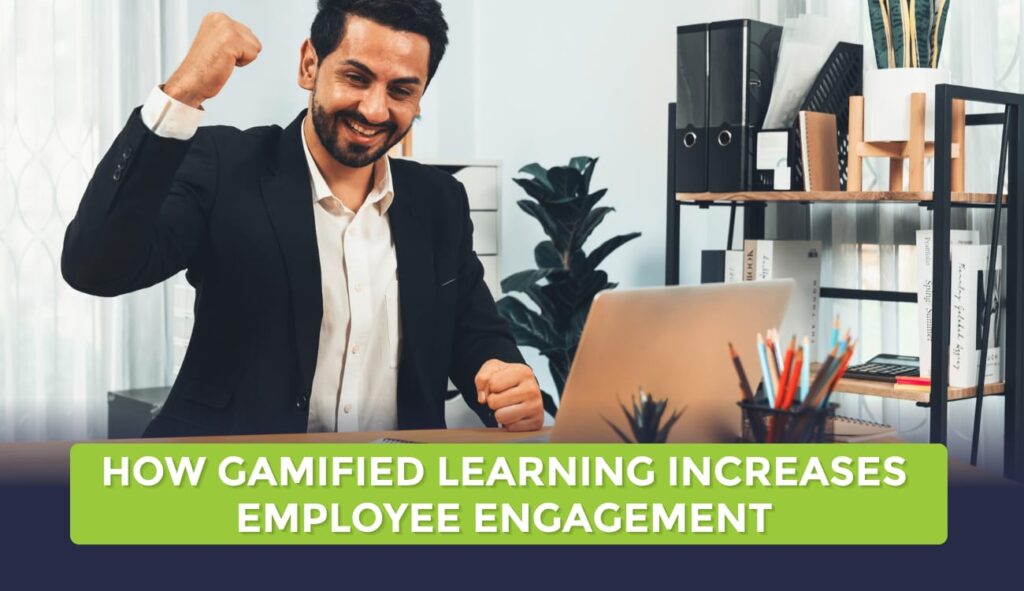
Why Employee Engagement Is Broken (and How Gamification Fixes It)
Despite endless surveys, feedback tools, and training programs, a significant part of the workforce remains disengaged, unmotivated, or just going through the motions. Traditional methods, like static eLearning modules, mandatory workshops, and one-size-fits-all training, feel more like chores than growth opportunities. They fail to create engagement, and they don’t stick.
In today’s fast-paced, distraction-rich working context, it has become even harder to gain and maintain motivation. Employees want to make real progress, get immediate feedback, and have purposeful work. What they’re often given instead is rigid compliance training or generic onboarding that barely scratches the surface of real commitment. This is where employee engagement gamification changes the game, literally.
Gamification takes the elements like points, levels, rewards, and competition that make video games addictive and applies them to a learning experience. The outcome is training that is more interactive, goals that are clearer, and progress that is measurable. It engages intrinsic motivation, curiosity, achievement, and mastery, turning learning into an active and interesting process.
What Is Gamified Learning?
Gamified learning refers to the process of applying game mechanics to training and development programs to make learning more attractive, motivating, and effective. In the workplace, gamified learning by corporate learning & development (L&D) professionals identifies with the potential to turn a traditional training experience into an interaction that promotes participation, space for information and enhanced employee collaboration.
Essentially, gamification and employee engagement do not mean turning work into play; instead, it is about incorporating aspects of game design that amplify the calculated outcomes a company may want to measure through training and experience.
Work gamification, incorporating real-world game mechanics, such as points, badges, leaderboards, rewards, and challenges, is designed to create a more engaging and motivating learning experience. Together, these elements develop passive learning into active participation.
Real Impact: Benefits of Gamified Employee Training
Gamified learning offers benefits beyond entertainment; it achieves real outcomes that are significant in your organisation. Companies using gamification for employee engagement in training programs find they have higher completion rates, as employees stay engaged and follow through when learning has an interactive aspect and is rewarding. It leads to better retention as games require people to repeat information and provide feedback.
Gamification does more than just improve required training; it encourages curiosity. Employees are much more likely to participate in optional learning experiences when it has rewards and is driven. Furthermore, gamified learning provides opportunities for team-based experiences and leaderboards that encourage competition and peer interaction. A gamified learning culture leads to team collaboration and motivation that creates a better working culture with elearning solutions.
According to an study by GCC Marketing, gamification proved to have a positive impact on energy, stress, and productivity levels of employees.
- 71% of employees said “yes” to increased energy levels
- 66% of them reported a decline in their stress levels
- 1/3 of them showed an increase in their productivity
Gamification Examples for Employee Engagement That Actually Work
Great gamification strategies are simple, scalable, and purposefully aligned with learning goals. Below are some gamification examples for employee engagement that have been used time and again to help engage employees:
Microlearning missions with points:
Ensure training is broken up into bite-sized tasks to keep the learning experience manageable while developing momentum. Have employees work through different modules and provide them with points for each one they complete. Divide them in groups to add a fun, competitive element for some healthy team bonding and development activities.
Weekly quizzes with leaderboards:
Gamify knowledge checks by ranking scores against other employees and creating a leaderboard. Leaderboards will create the need for consistent participation, which will spark ongoing value, as employees routinely check leaderboards and, to win, will have to prepare for knowledge checks. Deloitte’s Leaderboards survey shows an increase in participation in its digital leadership academy to help participants develop soft skills.
Skill challenge with digital credentials:
Engage employees with purposeful goals when onboarding them. A new tool to master, completes project-based tasks, etc. In a functional learning environment, employees who complete goals would gain access to badges or certifications they can display, proving they have developed new skills.
Instant recognition for completing training:
Celebrate training milestones in real time, to engage the audience with pop-up rewards, shout-outs, or letting them know internally. Knowing that their efforts and progress are recognised is significant in reinforcing hard work and engagement, while simultaneously showing great value to the employee and/or audience.
How to Gamify Employee Engagement
Gamify employee engagement is not about making training more enjoyable but about making the training more impactful. If gamification is implemented the right way with participants, it will work toward business goals, personal growth, and long-term development. Here are some ways to connect learning to gamification-
Set performance goals, not gameplay: All points, badges or leaderboards need to have a function. Gamified learning outcomes must tie to a relevant and measurable learning level objective, whether it’s increasing product knowledge, adopting new tech, or faster onboarding.
Tie activities to growth and career mobility: Gamification works best when development is substantive. If you create activities around training specific to building capacity that tie to upskilling, internal promotions or career pathways, employees will see value in participating.
Use it to review learning across multiple use cases: Gamified learning can be used to energise sales teams with performance challenges, carry onboarding through a series of step-based missions, put compliance into clearly defined knowledge checks and reward-oriented frameworks, and reinforce soft skills using scenario-based or technology-driven simulators.
Turn it over and keep it fresh: Employee gamification is a learning experience that should not get stale. Introduce new content; turn over or vary challenges, and regularly update rewards to keep the learning experience fresh and continually moving forward. Ask for feedback, take input from your employees and execute their ideas to create an inclusive environment.
Why CitrinLearn Is Your Partner for Smart Employee Gamification
At CitrinLearn, we do not simply add gamification as a feature; we design it as a strategy. Our platform is engineered to improve genuine engagement and performance through smart game mechanics. Employee engagement through gamification is seamlessly designed into every milestone of the learning journey.
Whether you are training a global enterprise or a rapidly growing team, CitrinLearn is built for scale. No matter what size your company becomes, our solutions will adapt to every department, function, and learning goal. All without the loss of experience or impact.
Ready to gamify your employee training? Talk to CitrinLearn today
Employee engagement doesn’t have to be dull; with the right tools and Custom Elearning Development your employees can have an interactive and fun learning experience! CitrinLearn gives you everything you need to create training programs that are intelligent, scalable, and built for meaningful impact.
Together, let’s turn your workforce into active learners and high performers. Contact CitrinLearn today to start building an employee training gamification experience that works!




